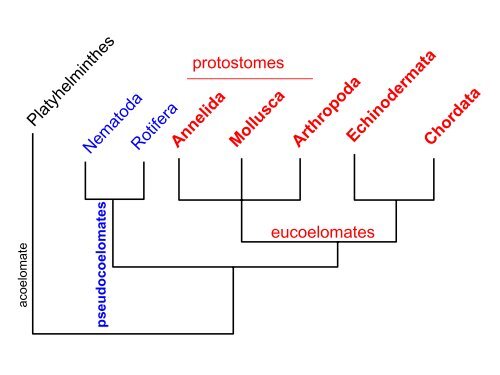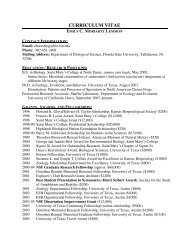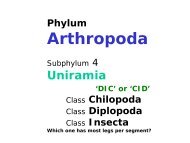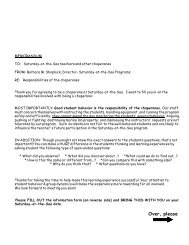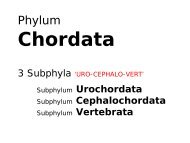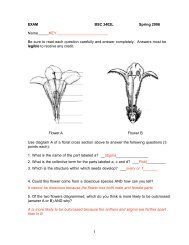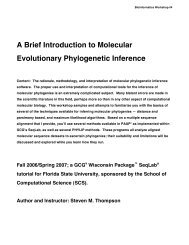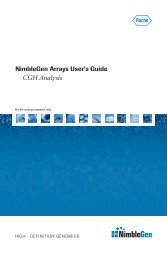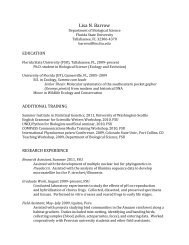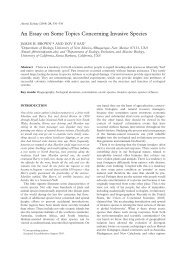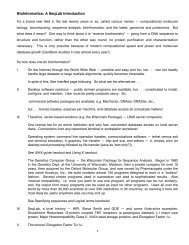Phylum Mollusca
Phylum Mollusca
Phylum Mollusca
Create successful ePaper yourself
Turn your PDF publications into a flip-book with our unique Google optimized e-Paper software.
acoelomate<br />
Platyhelminthes<br />
Nematoda<br />
pseudocoelomates<br />
Rotifera<br />
protostomes<br />
Annelida<br />
<strong>Mollusca</strong><br />
Arthropoda<br />
eucoelomates<br />
Echinodermata<br />
Chordata
<strong>Phylum</strong> <strong>Mollusca</strong><br />
“soft bodied”<br />
animals
<strong>Mollusca</strong> Characteristics<br />
Body Plan<br />
• head-foot: contains sensory organs and muscles<br />
• visceral mass: contains digestive, reproductive,<br />
circulatory organs<br />
• mantle: skin of the dorsal body wall secretes the<br />
shell (if there is one), cavity contains gills or lungs<br />
shell<br />
Visceral mass<br />
foot<br />
mantle<br />
mantle cavity
periostracum: conchiolin<br />
prismatic layer: calcium<br />
carbonate<br />
nacreous layer: calcium<br />
carbonate and proteins<br />
mantle
Digestive gland<br />
Mouth<br />
Shell<br />
Mantle<br />
Radula Nerve collar<br />
HAM<br />
(Hypothetical Ancestral Mollusc)<br />
head<br />
foot<br />
heart<br />
Nerve cords<br />
gonads<br />
Intestine<br />
coelom<br />
Nephridium<br />
Anus<br />
Gill
<strong>Mollusca</strong> Characteristics<br />
Feeding and Digestion:<br />
There are both free living and parasitic forms<br />
Most species use a tongue like organ called a radula when<br />
feeding
odontophore retractor<br />
radula protractor<br />
radula retractor<br />
odontophore<br />
protractor<br />
radula<br />
odontophore<br />
esophagus
<strong>Mollusca</strong> Characteristics<br />
Feeding and Digestion:
<strong>Mollusca</strong> Characteristics<br />
Digestive System<br />
• complete with regional specialization<br />
digestive<br />
gland<br />
stomach<br />
intestine<br />
anus
<strong>Mollusca</strong> Characteristics<br />
Gas Exchange<br />
• mainly gills, however terrestrial species have evolved<br />
lungs<br />
water<br />
axis afferent blood<br />
vessel: into gill<br />
efferent blood<br />
vessel: out of gill
<strong>Mollusca</strong> Characteristics<br />
Gas Exchange<br />
gill gill<br />
foot<br />
gill<br />
foot
<strong>Mollusca</strong> Characteristics<br />
Circulatory System<br />
• open circulatory system (in most classes)<br />
• heart and blood sinuses<br />
heart<br />
coelom
Excretion<br />
<strong>Mollusca</strong> Characteristics<br />
• most have kidneys (metanephridia)<br />
•tubules connecting pericardial cavity<br />
(coelom) and nephridiopore<br />
nephridiopore
<strong>Mollusca</strong> Characteristics<br />
Nervous system<br />
nerve ring<br />
pedal nerve cord<br />
visceral nerve cord
<strong>Mollusca</strong> Characteristics<br />
Reproduction<br />
• monoecious and dioecious species exist<br />
• usually internal fertilization<br />
• indirect development with the presence of a<br />
trochophore larva (link to annelids), and in most<br />
cases also a veliger larva<br />
trochophore veliger
Lampsilis ovata<br />
ovisacs<br />
The juvenile stages of some bivalves are parasitic
Glochidia: larval bivalves that are parasitic on fish gills
Lampsilis ovata<br />
ovisacs<br />
Some freshwater bivalves have evolved ways of attracting hosts<br />
for their larvae.
Some species place their larva in a lure called a superconglutinate<br />
http://courses.smsu.edu/mcb095f/gallery/L_perovalis/lampsilis_perovalis.htm
<strong>Mollusca</strong>n Radiation<br />
• There are approximately 128,000 living<br />
species in phylum <strong>Mollusca</strong> (35,000 are<br />
extinct)<br />
• The great morphological diversity is the<br />
result of elaboration on the basic body plan<br />
(HAM)
Digestive gland<br />
Mouth<br />
Shell<br />
Mantle<br />
Radula Nerve collar<br />
HAM<br />
(Hypothetical Ancestral Mollusc)<br />
head<br />
foot<br />
heart<br />
Nerve cords<br />
gonads<br />
Intestine<br />
coelom<br />
Nephridium<br />
Anus<br />
Gill
Scaphopoda<br />
• ventral shell<br />
fusion<br />
Bivalvia<br />
• bivalved shell<br />
• dorsal hinge<br />
<strong>Mollusca</strong>n Radiation<br />
HAM<br />
Gastropoda<br />
• torsion<br />
• coiling of the<br />
shell<br />
Polyplacophora<br />
• shell consists of 8<br />
plates<br />
Cephalopoda<br />
• lobed foot<br />
• highly developed head<br />
• shell reduced or lost
<strong>Phylum</strong> <strong>Mollusca</strong><br />
Class Gastropoda<br />
Class Bivalvia<br />
Class Cephalopoda<br />
Class Polyplacophora<br />
Class Scaphopoda
Class Gastropoda<br />
snails and slugs
Torsion<br />
• twisting of the visceral mass through a 180° rotation<br />
•1 st 90° rotation usually occurs at the veliger stage<br />
•the 2 nd 90° rotation usually takes longer and occurs later<br />
• after torsion, the anus and mantle cavity end up over the head<br />
• this poses a serious fouling problem and many gastropods have lost<br />
their right gills, kidneys and heart auricles<br />
mouth<br />
anus<br />
gills<br />
gills<br />
anus<br />
mouth<br />
anus<br />
gills
Larval torsion<br />
anus<br />
mouth
Planospiral shell<br />
Coiling<br />
Apex of shell<br />
extends out making the<br />
shell more compact<br />
Conispiral shell<br />
Shell shifts over<br />
body for better<br />
weight distribution
Class Gastropoda<br />
Subclass<br />
Prosobranchia Subclass<br />
Opisthobranchia<br />
Subclass<br />
Pulmonata
Class Gastropoda<br />
Subclass Prosobranchia<br />
• aquatic snails (marine and freshwater)<br />
• have undergone torsion and most have undergone<br />
shell coiling<br />
• have gills<br />
• all have shells<br />
• use radula for feeding; can be herbivores, carnivores,<br />
or detritivores<br />
In some, mantle extends over shell
Class Gastropoda<br />
Subclass Prosobranchia<br />
• snails often lay eggs in protective capsules
Class Gastropoda<br />
Subclass Opisthobranchia<br />
• sea hares and sea slugs (nudibranchs)<br />
• have undergone detorsion<br />
• have gills<br />
• sea hares have a reduced shell<br />
• sea slugs have no shell
mouth<br />
anus<br />
gills<br />
Detorsion<br />
They are missing the right gill,<br />
kidney and heart auricle
Class Gastropoda<br />
Subclass Opisthobranchia<br />
• sea hares and sea slugs (nudibranchs)
Class Gastropoda<br />
Subclass Opisthobranchia<br />
• they usually crawl along the bottom<br />
but many can also swim by using their<br />
modified mantle as “wings”
Class Gastropoda<br />
Subclass Opisthobranchia<br />
acts as<br />
male only<br />
• all are monoecious<br />
• sea hares often form “mating chains”<br />
act as both males<br />
and females<br />
simultaneously<br />
acts as female<br />
only
Class Gastropoda<br />
Subclass Opisthobranchia<br />
• sea slugs often lay “ribbons” of eggs which<br />
stick to the substrate
Class Gastropoda<br />
Subclass Pulmonata<br />
• land snails and land slugs<br />
• have lungs<br />
• land slugs have undergone detorsion and have lost<br />
their shell
Class Bivalvia<br />
(class Pelecypoda)<br />
the “bivalves”
Class Bivalvia<br />
• clams, mussels, oysters, scallops<br />
• use gills for respiration and filter feeding<br />
• shell is modified into a bivalved shell connected by<br />
muscles and ligaments<br />
• no head (reduced sensory organs), no radula<br />
• foot can be modified for digging<br />
posterior<br />
dorsal<br />
ventral<br />
umbo<br />
-the oldest part of the shell<br />
anterior<br />
ridges show where<br />
mantle has laid<br />
down shell
siphons<br />
foot
mouth<br />
foot<br />
labial palps<br />
gills<br />
excurrent siphon<br />
Incurrent siphon
intestine<br />
anus
Zebra Mussels: Dreissena polymorpha<br />
Native to Asia, introduced to the North America in ballast water
Consequences of zebra mussel invasion:<br />
1. Decrease in phytopalnkton (increase in water clarity)<br />
2. Change lake food webs<br />
3. Out compete native mussels<br />
4. Cause physical damage to water intake pipes
Richard E. Young, Michael Vecchione and Katharina M. Mangold<br />
Class Cephalopoda<br />
the squids, octopus, nautilus, and cuttlefish
Class Cephalopoda<br />
• shell is present, reduced, or lost<br />
• all are predacious with beak-like jaws<br />
• highly developed head and sensory organs (very<br />
intelligent)<br />
• closed circulatory system<br />
• swim via jet propulsion<br />
• foot is lobed and forms tentacles<br />
• direct development (no larvae)
Class Cephalopoda<br />
Nautilus:<br />
• have a chambered shell that aids<br />
in maintaining buoyancy<br />
• chambers are filled with gas<br />
chambers siphuncle<br />
(cord of tissue<br />
connected to<br />
visceral mass)
Class Cephalopoda<br />
Squids:<br />
• have a reduced, internal shell shell<br />
called the pen<br />
Cuttlefish:<br />
• have a reduced, internal shell<br />
called a cuttlefish bone
Class Cephalopoda<br />
Octopus:<br />
• have lost the shell completely<br />
• most intelligent invertebrate
Class Cephalopoda<br />
Reproduction<br />
• male transfers a spermatophore to female<br />
using a special pair of tentacles<br />
• female seals herself up in a den to lay eggs<br />
which she attaches to the top of the den<br />
• she cares for these eggs (in some species up<br />
to 6.5months)<br />
• after the eggs hatch she usually dies
Class Cephalopoda<br />
• the largest giant squid found to date have<br />
been 18 meters in length<br />
• they live in the deep sea<br />
• sperm whales (~20m in length) are their<br />
major predators
Class Polyplacophora<br />
the “chitons”
girdle<br />
plates<br />
Class Polyplacophora<br />
• have 8 rows of articulating plates<br />
• use radula to graze algae on substrate<br />
• mantle forms a girdle around plate edge<br />
• no veliger larvae
Class Scaphopoda<br />
the “tusk shells”
Class Scaphopoda<br />
• shell is modified into hollow tube that is open at<br />
both ends<br />
• the mantle wraps completely around the visceral<br />
mass<br />
• sessile and feed in sediment<br />
located above<br />
sand<br />
located below<br />
sand<br />
feeding<br />
tentacles


